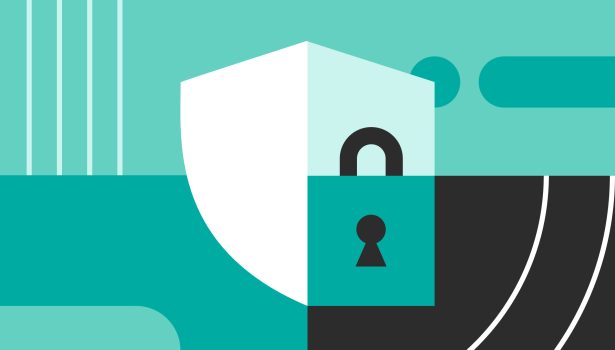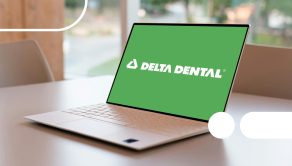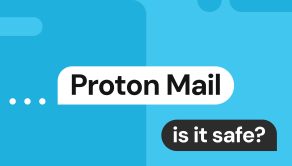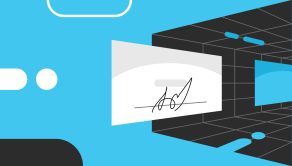Dark web protection: how to keep your data safe

The dark web has plenty of legitimate use cases. But it also acts as a marketplace for stolen data—names, credentials, addresses, SSNs, and even credit card details—that can lead to identity thefts, financial losses, and reputation damage for companies.
Data is often copied and resold multiple times on underground forums, making it difficult to trace or remove once leaked. Dark web protection helps you stay informed about any leaks and prevent this data from being abused against you by enabling faster detection and mitigation.
Read on to learn more about steps, tools, and recommendations for securing your personal and business information before scams happen.
What is dark web protection?
Dark web protection is a set of tools and measures used to monitor the darknet for compromised data. These security measures help detect and proactively respond to data exposure—personal details, logins, medical or financial information, or company credentials—being available on underground marketplaces and forums.
For individuals, dark web protection helps safeguard online accounts and personal identity by providing early alerts about potential data exposure. For businesses, it works as an early warning system, notifying security teams when employee credentials or proprietary data surface online, helping to prevent financial losses and large-scale data breaches.
Why is dark web protection important?
The dark web’s anonymity attracts criminals who can buy and sell users’ sensitive information. Protection focuses on keeping users informed if any data is found on the dark web, allowing them to:
Prevent identity theft
Cybercriminals can use the dark web to impersonate you by using stolen personal data, including your Social Security Number (SSN), medical ID, and login credentials. With this data, hackers can open fraudulent accounts, make purchases, receive medical care, and even commit tax fraud—all in your name. Protection involves practicing strong password hygiene, using a password manager, enabling multi-factor authentication, and utilizing dark web monitoring services.
Secure financial information
Hackers steal financial details through breaches, phishing, skimming, or malware. Data like credit card numbers, bank account details, credit reports, and transaction history can later appear on the dark web, copied and resold, making it nearly impossible to remove once leaked. Protecting your financial information in such a case usually involves notifying credit bureaus to place fraud alerts or credit freezes to restrict access and prevent unauthorized banking activity.
Protect business data and reputation
One security lapse can quickly spiral into a massive data breach, PR crisis, and long-term reputation damage. It often takes only one employee clicking on a phishing link or accidentally downloading malware to grant access to intellectual property or customer records, which are later sold on the dark web.
Aside from maintaining a strong cybersecurity policy within the company, businesses can opt for dark web monitoring that acts as a digital security camera, scanning the Internet and alerting them to threats. Dark web monitoring tools allow companies to identify leaked data available in encrypted forums and dark web marketplaces.
Dark web protection for individuals
Since it’s almost impossible to remove data from the dark web, individuals should focus on preventing it from appearing there in the first place:
Protect your accounts with strong and unique passwords
Reused passwords are a top driver of dark web-related attacks as they open doors for a credential stuffing tactic—an automated attack where cybercriminals use previously stolen username-password pairs to exploit reuse across services at a massive scale.
Protection from password stuffing and identity theft starts with paying attention to overall password health. It involves:
- Identifying weak, compromised, and old passwords
- Review and update passwords in all your active accounts
- Delete old and unused accounts
- Apply multi-factor authentication everywhere it is possible
- Delete saved passwords from notes, Notion, and any other similar apps or storage tools
- Choose a secure password manager for all active and future credentials
Think of a password manager as a concierge that remembers which passwords go with which site or app. Such software is more than a simple database—it ensures a high level of protection by encrypting your passwords, storing them in a secure vault protected by a master password.
Enable two-factor authentication
Multi-factor authentication neutralizes credential stuffing as it makes leaked passwords useless on their own and notifies you when someone tries to log into one of your accounts.
1. Start with your most critical accounts: emails (particularly your primary address), banking and investment platforms, cloud storage services (iCloud, Google Drive, Dropbox), and accounts using social login (“Sign in with Google”).
2. Choose app-based 2FA: authy or Google Authenticator are more secure than SMS-based codes, which can be disrupted by SIM-swapping attacks.
3. Store your backup or recovery codes in a secure place: you will need them if you lose access to your 2FA.
Be cautious with phishing emails
Databases available on the dark web provide attackers with access to vast amounts of stolen personal information. Sourced from data breaches, these databases have proliferated and are often offered at low cost, containing details like email addresses, passwords, and credit card details—all of which can be used to create tailored, highly convincing phishing emails.
Although criminals will only improve at making legitimate-looking emails and using phishing kits, there are a few common red flags to watch out for:
- Misspelled domains: it’s common to see near-identical domain names to legitimate ones—hackers often change just a single letter or add a number, which can easily go unnoticed unless you keep an eye on such details.
- Mismatched sender and domain names: while display names often look legitimate, the sender’s email address doesn’t always match the company’s domain name.
- Sense of urgency: hackers can trick you into taking action without verifying the email’s legitimacy by adding a timeline. For example, a requirement to fill out an employer form within a short timeframe, notification of your account being locked, or that it has even been hacked.
- Generic domain extensions: phishing emails often come from public or generic domain extensions (e.g., @gmail.com instead of a corporate domain like @company.com).
Monitor unusual activity on financial and online accounts
Credit card details can be stolen, online banking accounts hacked, and scammers can take your identity to buy things or intercept and steal income tax refunds—the list of potential financial frauds is long, and new types of fraud are continually evolving. Regular monitoring helps mitigate most of the risks, or, at least, reduce the potential for greater damage.
Consider the following steps:
1. Set up instant transaction alerts and credit monitoring
Most credit or debit card issuers provide almost immediate notifications that inform you if any transaction has occurred, either by email, SMS, or both. You can also set up other types of automatic notices to alert you as soon as a specific account balance drops or rises above a set amount.
Credit monitoring services will also help you quickly identify any suspicious activity, like new accounts being created, hard inquiries, or drops in your credit score. IdentityForce, Aura, and myFICO are among the commonly used idenity protection services that include credit monitoring as one of their features.
2. Check bank/card accounts regularly
Consider setting up a monthly schedule where you go through your accounts and transaction history to detect suspicious activities like:
- Active accounts you don’t remember opening
- Charges you don’t remember making (bill for an item you didn’t actually purchase)
- Some companies are making credit inquiries on you, but you haven’t applied for one
- Credit card charges (even small ones) or other transactions from a foreign country you’re not associated with
- Duplicate charges that shouldn’t be recurring
3. Keep an eye on suspicious login behaviour
This could include logins from unfamiliar locations, devices, repeated failed login attempts, and logins at odd hours of the day. These suspicious signs often mean that one of your accounts has been compromised or someone is trying to gain access to it.
Once noticed, check the device and location to verify it isn’t someone you know or someone you’ve granted access to. If you suspect any unauthorized activity, change the password for this account as soon as possible and add 2FA (if not already implemented). Then check if any of your accounts have the same password as the compromised one to prevent credential stuffing.
Use breach alerts to catch leaks before they spread
You don’t have to wait for signs of misuse—breach alert tools powered by dark web monitoring help you detect data exposure early, before your information is weaponized. These services notify you as soon as your personal details—like emails, passwords, or Social Security Numbers–appear in known breaches or darknet marketplaces. With early breach alerts, you can quickly change credentials, freeze accounts, or take other protective steps before the data is exploited.
How businesses can strengthen dark web protection
Small and large companies are popular targets for cybercriminals, as they operate with a wide range of customer data that can later be found on darknet forums and marketplaces for sale. So, how can a business protect itself from the dark web and its threats?
Implement dark web monitoring for company assets
Dark web monitoring tools help scan the darknet for company mentions, leaked employee login details, or other suspicious activity. While not the same as full threat intelligence platforms—which may also track malware campaigns, hacker tactics, or global threat trends—these tools play a crucial role in identifying data exposure and guiding incident response. It’s important to note that no monitoring tool can access every corner of the dark web, especially encrypted or private forums. Still, they provide valuable alerts that help companies respond quickly and strengthen authentication protocols to prevent unauthorized access.
These tools scale well for both small teams and large enterprises, offering affordable and user-friendly dark web monitoring solutions with clear alerts and easy setup. Consider tools like SearchLight or services from LifeLock companies for timely alerts on exposed credentials and company-related sensitive data.
Educate employees on dark web threats and phishing attacks
One-time cybersecurity training isn’t enough given the persistence of current threats. Instead, focus on:
- Raising awareness of how exactly each employee’s actions can impact the company in terms of data protection
- Showing real-life examples of threats and reinforcing security training through simulations (phishing, fake login prompts, and impersonation)
- Hiring a cybersecurity penetration testing team to identify vulnerable spots within the company’s ecosystem
- Educating employees on the steps they should take to support the company’s recovery plan after a breach
Strengthen access controls to secure team logins and sensitive data
Role-based access control is an essential component of cybersecurity, as it regulates who can view, open, edit, use, or access a particular company resources:
- Minimize over-permissioned or “always-on” access: a survey by Centrify found that 74% of recent data breaches involved the abuse of privileged credentials. Always-on privileged access increases security risks, leading to credential theft, phishing threats, and compliance violations. Choose just-in-Time (JIT) access for temporary, need-based privileges to reduce the attack surface and prevent privilege misuse.
- Use password managers across teams to eliminate credential sharing: a team password management app gives employers visibility and control over how passwords are created, used, and shared, reducing the risk of breaches.
- Add 2FA for critical business platforms: even if a breach occurs, leaked credentials can circulate on the dark web marketplaces, copied and resold multiple times before being exploited. Adding 2FA helps prevent unauthorized access and alerts an organization to such attempts.
Dark web protection tools and services
Dark web monitoring tools continuously scan the murkiest corners of the Internet—breach dumps, darknet forums, and marketplaces—for data leaks. Whenever your personal or company data is detected, you receive notifications to help you take proactive measures and protect your accounts before it’s too late. Dark web monitoring tools can’t remove your data from the darknet, but they help users act quickly when exposure is detected.
Monitoring and credit protection services
A quality dark web monitoring tool isn’t just about scanning. Choose tools that offer breach context, real-time alerts, and are bundled with credit freeze, identity protection and identity theft restoration. These tools are particularly useful for SSN leaks, financial fraud risks, and identity theft cases:
Aura: helps detect potential scam calls and texts before they turn into identity theft. It includes antivirus protection, a basic VPN, parental controls, credit score monitoring with all three bureaus, data breach alerts, dark web scanning, and white-glove fraud remediation.
Log360: offers real-time threat intelligence, dark web monitoring for leaked sensitive information, instant alerts, an Incident Workbench with contextual data analysis, advanced analytics, and monitoring capabilities that provide comprehensive security visibility.
Password managers with breach monitoring
These tools encrypt all your passwords and then actively check against databases of known data breaches to alert you in case your credentials have been leaked. Being a low-effort protection against the dark web that most people should have in place, password managers with breach monitoring also offer breach history, inform you about reused passwords, and support auto-updates to maintain strong credentials hygiene.
Here are some tools to consider:
- RoboForm
- 1Password
- Keeper
Dark web protection services for businesses
Although we often see breaches at larger companies, small teams are also frequent targets for hackers, as they handle large volumes of sensitive customer data daily, including financial and personally identifiable information (PII). When it comes to dark web protection for business needs, there should be a different angle to focus on: scanning for leaked employee credentials, company mentions, exposed business domains, and compromised admin accounts.
Key features to look for:
- Real-time alerts: notifications should appear as soon as your data is found on the darknet.
- Data types coverage: a good dark web monitoring tool should scan not only for name, email, and address data but also monitor leaked SSN, credentials, and financial data.
- In-depth search: the ideal service should be able to monitor an extensive range of regular and .onion websites (those available on the dark web), including forums, marketplaces, private networks, and select social media platforms where cybercriminal activity may occur.
- User-friendly interface: it’s best to have both desktop and mobile versions with a simple and understandable interface, so it helps rather than puts you in a puzzle-solving mode every time you check for updates.
- Recovery and support services: it’s especially important for data leaks that lead to identity theft (SSN, financial information, and credentials for key accounts). A quality dark web monitoring tool should offer a recovery plan for password changes, contact the three main credit bureaus to initiate a credit freeze, and fraud alert.
FAQs
What are the best dark web protection services?
LifeLock, Log360, Identity Guard and Aura are among the best dark web protection
tools, offering broad coverage, recovery plans, instant notifications, and advanced features for both individuals and organizations.
How can I prevent my data from being exposed on the dark web?
Create strong passwords and update them in a timely manner, use a password manager and 2FA, and install dark web monitoring tools to identify which data might have been exposed to take more proactive measures. You can also use the Onerep tool, which helps remove leaked data from data brokers and prevents it from appearing on the dark web.
Can businesses fully protect themselves from dark web threats?
No company or service is 100% immune to cyberthreats, though implementing all security practices ensures minimal risk. Dark web monitoring tools will also help companies stay informed about any potential threats, while the Onerep tool can l be an effective solution for removing compromised information before it appears in the unreachable areas of the darknet.





Mikalai is a Chief Technical Officer at Onerep. With a degree in Computer Science, he headed the developer team that automated the previously manual process of removing personal information from data brokers, making Onerep the industry’s first fully automated tool to bulk-remove unauthorized profiles from the internet.